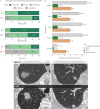First assessment of photon-counting CT for virtual bronchoscopic navigation
- PMID: 39915055
- PMCID: PMC11965957
- DOI: 10.1183/13993003.02476-2024
First assessment of photon-counting CT for virtual bronchoscopic navigation
Abstract
Virtual bronchoscopic navigation (VBN) with photon-counting CT reduces radiation dose by 83% compared to energy-integrating CT, meeting the threshold for lung cancer screening and the high resolution standards required for accurate VBN
Conflict of interest statement
Conflict of interest: F. Funke received speaker honoraria from Broncus Medical. K. Darwiche received travel support and research grants from Broncus Medical. The other authors declare that they have no known competing financial interests or personal relationships that could have appeared to influence the work reported in this paper.
Figures

Comment in
References
Publication types
LinkOut - more resources
Full Text Sources
